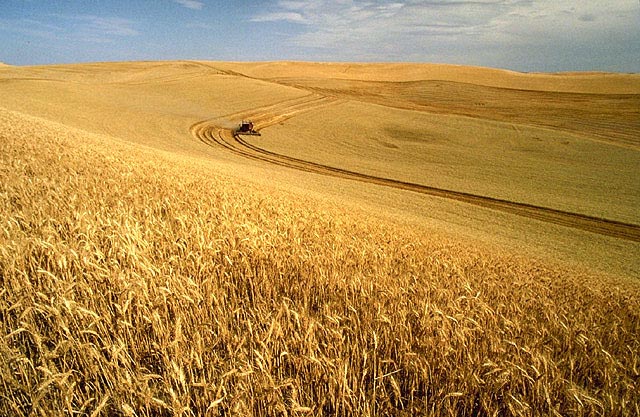FAO’s latest forecast for global cereal production in 2018 has been raised by 3 million tonnes since the previous report in September, to 2 591 million tonnes; still 63 million tonnes (2.4 percent) below last year’s record high.
World wheat production in 2018 is forecast at 722.4 million tonnes, nearly unchanged from the previous month and representing the lowest level since 2013. Latest revisions mostly concern prospects in Australia and Canada, which are dampened on expectations of lower yields because of reduced rainfall, offsetting higher forecasts for Algeria and the Russian Federation.
World production of coarse grains in 2018 is forecast at 1 356 million tonnes, 2.2 million tonnes higher than last month’s expectations, but still 35.6 million tonnes (2.6 percent) below the 2017 output. The upward revision mostly stems from improved prospects for maize yields in the United States, where the output is expected to be the second highest on record. Production forecasts for coarse grains are also raised for Algeria, where favourable weather has boosted this year’s harvest. These increases more than outweigh downward revisions made for Serbia and the Russian Federation, where adverse weather has further lowered yield prospects for maize.
Global rice production in 2018 is anticipated to amount to 513 million tonnes, up 1.3 percent from the 2017 all-time high and 1.2 million tonnes above September’s forecast. The month-on-month upward adjustment follows evidence of greater Asian plantings than previously foreseen, particularly in India. Nonetheless, crop prospects have also improved for the United States and Guinea, while inclement weather or short water availabilities for irrigation dampened the outlook for Mali, Pakistan and the Philippines.
The forecast of world cereal utilization in 2018/19 stands at 2 647 million tonnes, almost unchanged from September and still up almost 30 million tonnes (1.1 percent) from the 2017/18 estimated level. Feed and industrial uses of maize make up the bulk of the anticipated increase in global cereal utilization. Feed use of maize in 2018/19 is projected at 624 million tonnes, an increase of almost 20 million tonnes (3.3 percent) on the previous season, although this is likely to be largely offset by expected reductions in the feed use of barley, sorghum and other coarse grains. The use of wheat for both feed and industrial ends is expected to decline slightly, while the direct human consumption of wheat is set to rise in line with population growth. As regards rice, greater food intake is envisaged to sustain a 1.1 percent expansion in global rice utilization in 2018/19 to 509 million tonnes, eclipsing anticipated declines in the feed and industrial uses of the commodity.
Global trade in cereals is expected to approach 417 million tonnes in the 2018/19 marketing season, up 3 million tonnes from last month’s forecast but still 4.1 million tonnes (1.0 percent) short of the 2017/18 record level. The upward revision since last month mainly reflects higher maize trade than was earlier anticipated, mostly on expectations of larger imports by several Asian countries and the EU. Global wheat trade in 2018/19 (July/June) is forecast to decline by 1.5 percent from the 2017/18 near-record level, largely on anticipated overall smaller purchases by Asia. Nonetheless, to meet the current foreseen import demand, wheat shipments from the United States are expected to increase sharply, offsetting lower export supplies in the Black Sea region and the EU. International trade in rice is forecast to subside by 1.3 percent in calendar year 2019, to total 48 million tonnes, with sales by Brazil, Pakistan and Thailand seen to be the most affected by the slight trade contraction.
World cereal stocks by the close of seasons in 2019 are now forecast at 751.3 million tonnes, 9.5 million tonnes (1.3 percent) up from the September forecast, but still down 57 million tonnes (7 percent) from their record high opening level. However, despite this month’s increase, the stocks-to-use ratio of cereals in 2018/19 could decline to 27.7 percent, the lowest level since 2013/14, but still well above the historical low of 20 percent registered in 2007/08. Global wheat stocks (ending in 2019) are forecast to total 255.5 million tonnes, up slightly from last month but almost 18 million tonnes (6.4 percent) below their record opening level. The sharp decrease from the previous season largely reflects expected significant drawdowns in the EU (by 7.5 million tonnes), the Russian Federation (by 5.9 million tonnes) and the United States (by 4.5 million tonnes). Overall, the global wheat stocks-to-use ratio will likely drop to 33.7 percent from 36.9 percent in 2017/18. The forecast of world coarse grain inventories (ending in 2019) has also been raised this month, by 3.3 million tonnes (1 percent), to nearly 320 million tonnes. Much higher maize inventories foreseen in the United States, following the near-record crop expected this year, account for the bulk of the revision. Despite the latest upward adjustment, coarse grain stocks will still likely remain below their opening levels, by as much as 44 million tonnes (12.1 percent). Global rice stocks at the close of 2018/19 are pegged at 177 million tonnes, up 2.6 percent from their opening levels and 3.1 million tonnes from the September forecast. India accounts for nearly all of this month’s upward stock adjustment for rice. This is consistent with the buoyant outlook for Indian production this season and expectations of continued sizeable state purchases from the local market.





